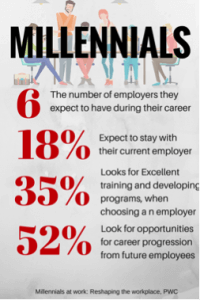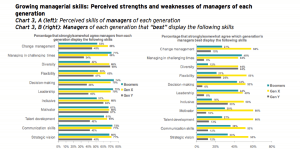 Older Millennials are entering their 30’s. Many are already in high executive positions and are starting to assert new leadership of corporate America. Soon, most executives you meet will be Millennials. They are already shaping Corporate America and are bringing changes that for most of us are unheard of.
Older Millennials are entering their 30’s. Many are already in high executive positions and are starting to assert new leadership of corporate America. Soon, most executives you meet will be Millennials. They are already shaping Corporate America and are bringing changes that for most of us are unheard of.
Millennials are Moving Up Fast
In many organizations, Millennials are moving into management and leadership roles earlier in their careers than previous generations did. There’s a good reason why this is happening.
- Demographically, Millennials became the largest generational cohort in the U.S. workplace in March 2015.
- At the same time, changes among previous generations are opening up new opportunities quickly for this large group. Baby Boomers are retiring at the rate of 10,000 per day in the U.S. Generation X-ers—the group currently in their forties and fifties—are too small a generation to fill all the leadership slots opening up as Boomers retire.
- Millennials have to fill that gap. Organizations need to make sure their millennials are ready to step to the plate.
Who are the Millennials?
To understand the executive Millennial, let’s take a look at what is important to Millennials in general. A recent survey report by PwC uncovered the differentiators of the Millennial employee.
- They expect to have six employers or more during their lifetime
- Only 18% expect to stay with their current employer for the long term.
- Development and work/life balance are more important than financial reward
- Over half said that while companies talk about diversity, they did not feel that opportunities were equal for all.
- They prefer to communicate electronically at work than face to face or even over the telephone. Technology is often a catalyst for intergenerational conflict in the workplace and many Millennials feel held back by rigid or outdated working styles
- Career progression is the top priority for Millennials who expect to rise rapidly through the organization
- Millennials are attracted to employer brands that they admire as consumers
- Millennials have a strong appetite for working overseas
- They feel that their managers do not always understand the way they use technology at work.
The report finishes by stating that Millennials aren’t afraid of change, in fact, they expect change. Development is at the top of their needs and wants, and the use of technology is a given.
The Millennial Executive?
A Virtuali study reports that 50 percent of the Millennial respondents to their survey were already in leadership positions. The study found that 64 percent of them felt unprepared for their role when accepting the position. This suggests that even current and aspiring millennial executives are looking for guidance and coaching. The Millennial executive “profile” is a bit different from older generation leaders. What they want and drive them is very specific, a recent article in Linkedin perfectly summarizes what Millennial Executives are looking for:
- Millennial executives value impact and are primarily looking to change how everyday things are done by creating products and services that go beyond solving problems. They want to make a real change in the world. They want to be disruptive.
- Millennials have a natural ability to keep official engagements informal but professional. I have visited enough offices in Silicon Valley to know that wearing a suit might be overdressing.
- Millennial executives will give the job to the most innovative and cost effective supplier every single time.
- Millennial executives expect results and care very little for excuses.
- Millenial executives see diversity and inclusion differently. They want a collaborative environment where everybody can to contribute.
The Millennial Executive Leadership Style
Deloitte in its 2015 “Mind the Gaps” survey has “mapped” the leadership style of Millennials . According to their report, Millennial leaders have a “socially focused” perception of leadership. The personality traits of individuals identified as “true leaders” include:
However, A recent survey report by Earnest and Young explores the strengths and weaknesses of Millennials. Millennials in management positions are perceived to be less versed at managing others compared to Boomers and Gen X.
The graph above shows A) the perceived skills of each generation (left) and B) perception of managers that best display the management skills (right).
Interestingly, diversity is a growing strength in Millenials. They (Millennials) surpassed Gen X managers in displaying “diversity” managerial skills, or the ability to build culturally competent teams and to not discriminate based on race, gender, sexual orientation, age, physical abilities, etc. However, when people were asked which manager (one from each generation) displays best the particular skill. Millennials earned the least mentions as the “best” at displaying eight of eleven management skills. Nevertheless, they outpaced boomer managers in their ability to be the best “inclusive” leaders or involving a diverse set of people in providing opportunities, developing strategies and making decisions.
With Boomers on their way out and a tidal wave of 18- to 34-year-olds entering the workforce, Millennial managers are an inevitability we need to embrace. Being proactive in preparing these individuals in a way that speaks to their leadership style is a competitive advantage to any company.
_____
This blog post first appeared in LinkedIn and it was written in collaboration with our friends at RD Partners.
We work with organizations, leaders, and teams who believe that leadership development should be tied to strategic goals and measured for results. Our clients estimate annual ROI of their coaching engagements between $300K-$2M annually. Learn more at www.rdpusa.com and www.velasconsulting.com


